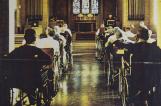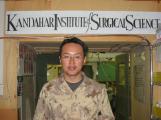1
2000Sunnybrook is the first in Canada to show the use of Intravenous Immunoglobulin (IVIG) in the treatment of patients with Toxic Epidermal Necrolysis (TEN)
2000
Sunnybrook clinicians are the first in Canada to determine the importance of base deficit in the outcome of burn patients
2000
Sunnybrook is the first in the world to incorporate the Acute Physiology and Chronic Health Evaluation II (APACHE II) score into a formula to predict the probability of death in patients with burn injuries
2000
Sunnybrook is the first in Canada to establish a Patient Safety Unit
2000
OCC is the first in Canada to offer conformal radiation for selected sites using Intensity Modulated Radiotherapy (IMRT)
2000
OCC is a first in Canada involved in the development of a vaccine for treatment of malignant melanoma
2000
Scientists are the first worldwide to show that much lower doses of chemotherapy in combination with anti-angiogenic drugs (that stop the development of blood vessels in tumors) will significantly delay tumor progression in animal models. If successful, this treatment will have less severe side effects than conventional treatments, and could help to prevent drug resistance
2001
Studies presented at the American Burn Association annual meeting are the first in Canada to show the under-reporting of patients with Toxic Epidermal Necrolysis (TEN) and the utilization of telemedicine for follow-up of burn patients
2001
Sunnybrook is the first in Canada to provide a dedicated centre for seniors suffering from serious dementia: the Dorothy Macham Home features unique elements that ensure the comfort, freedom and safety of residents
2001
Sunnybrook and collaborators at the University Health Network and Osaka University in Japan are the first worldwide to discover a protein in human breast milk that stimulates the immune system of newborns
2001
Researchers conduct the first international multi-centre randomized clinical trial evaluating risks and benefits of caesarean versus vaginal birth for breech pregnancies. The results indicate caesarean sections for breech pregnancies offer overwhelming benefits for both mother and child
2001
The Neurosciences Alliance is a new leading edge endeavour combining the strengths of Sunnybrook, Baycrest Centre for Geriatric Care and St. John's Rehabilitation Hospital to provide the most advanced care, research and educational opportunities in cognitive and rehabilitation neuroscience related to aging and brain dysfunction from stroke, mood disorders, head trauma, and neuro-degenerative disorders such as Alzheimer's Disease.
2002
Sunnybrook is the first in the world to use the Near Infrared Spectroscopy and Imaging to determine the depth of burn injuries
2002
Sunnybrook is the first in Canada to present an emergency plan for mass burn casualties
2002
Orthopaedic & Arthritic Hospital is the first in Canada to offer minimally invasive total hip replacement surgery - the future of hip replacement surgery
2002
The first spine surgery is performed using a Prosthetic Disc Nucleus, as part of a multi-centre Canadian trial
2002
Scientists are the first in the world to demonstrate that a cell population of unknown function, but present in the gut of normal individuals, plays a central role in preventing the development of ulcerative colitis
2002
Sunnybrook shows that young women with mutations in the BRCA1 gene, a common mutation in Canadian women, have a much higher risk of breast cancer if they use the birth control pill
2002
Cardiac surgeons are the first in Canada to successfully perform a Modified Maze procedure, a unique new procedure to treat atrial fibrillation, a common heart rhythm disorder that may lead to stroke or heart failure, without stopping the heart
2002
Sunnybrook scientists are first in the world to create a simple system to generate T-cells, a vital component of the immune system that orchestrates, regulates, and coordinates the overall immune response, in a petri dish. This discovery provides a method to create model systems to study the genetics and molecular biology related to T-cell development, and points toward future clinical therapies for persons with HIV and cancer
2003
Schulich Heart Centre specialists implant the first Insync III Marquis device in Canada to provide cardiac resynchronization therapy as well as defibrillation therapy in patients for the treatment of life-threatening arrhythmias and heart-failure symptoms
2003
In partnership with The Ottawa Hospital and Baycrest Centre for Geriatric Care, Sunnybrook is part of the Heart and Stroke Foundation of Ontario Centre for Stroke Recovery, a new leading-edge centre of excellence that will lead to major advances in stroke prevention, treatment, and recovery, improving the quality of life for patients and their families
2003
A first in North America, Magnetic Resonance Direct Thrombus Imaging (MRDTI) is a new MRI technique that aims to prevent stroke and heart attack by detecting dangerous plaque in the arteries of patients who do not have symptoms
2003
OCC is the first cancer center in Canada to have a PET/CT unit installed and used in a radiation therapy department for research into the use of this combined modality scanner in radiation therapy treatment planning
2003
Along with researchers at Caprion Pharmaceuticals, S&W is the first in the world to discover a way to make the immune system specifically recognize infectious prions, proteins that cause brain-wasting diseases like mad cow disease and Creutzfeldt-Jakob Disease, its human equivalent. This discovery paves the way for the development of diagnostic tools, immunotherapy and a vaccine
2003
Sunnybrook opens the largest SARS unit in the GTA, treating the most SARS patients outside of Asia
2003
Sunnybrook campus sets up the first North American SARS assessment clinic within 24 hours, which becomes the blueprint for other clinics in Ontario
2003
Scientists discover that TRP-2, a gene involved in melanin synthesis, is responsible for drug and irradiation resistance in human melanoma
2003
A Sunnybrook researcher is appointed to lead the committee to establish standards for digital mammography that will be used throughout the U.S. health care system
2003
A Sunnybrook scientist is the first in the world to discover a molecular marker to diagnose hepatocelular carcinoma (HCC), the most common type of liver cancer. Sunnybrook has developed a test for the early diagnosis of HCC, which could also be useful for the screening of individuals that are at high risk of developing this disease
2003
Scientists publish the first results in the world that use digital mammography with a contrast agent (dye) to show tumors that cannot be viewed with current clinical mammography
2003
Sunnybrook clinical epidemiologists use the first worldwide application of large database time series analysis to examine causes of emergency department overcrowding in Canada
2004
First in Canada to show the frequency of late consequences of patients with Toxic Epidermal Necrolysis, a finding presented at the American Burn Association annual meeting
2004
Neuroscientists use wireless handheld technology to collect data from patients with bipolar disorder - more than 40,000 responses - and thereby build the largest database of its kind in Canada. This allows the analysis of mood dynamics with unprecedented detail
2004
Surgeons at the Schulich Heart Centre successfully perform the first minimally invasive thoracoscopic modified Maze procedure in Canada, to treat atrial fibrillation, a heart rhythm disorder that may lead to stroke or heart failure
2004
Cardiologists at the Schulich Heart Centre successfully implant one of the first InSync Sentry cardiac resynchronization therapy defibrillators (CRT-D) in Canada, signalling a new era in heart failure management with the convergence of clinically proven therapy, sophisticated diagnostics and advanced warning capabilities in a single implantable device. When used with other standard clinical assessments, the InSync Sentry enables early warning of fluid accumulation and appropriate clinical response by the clinician
2004
A study by medical oncologists and imaging researchers finds MRI to be more effective in detecting breast cancer in high-risk women
2004
Radiation oncologists at OCC successfully complete the first breast cancer treatments in the world implanting small beads of palladium, a one-day outpatient technique that has the potential to dramatically change the treatment of breast cancer
4
Atrium of Sunnybrook Health Science Centre's new Clinical Services Wingapprox 1997
Toronto, Ontario, Canada

6
Sunnybrook deals with Sars20 April 2003
Toronto, Ontario, Canada
 Credits:
Credits:The Canadian Press
Tibor Kolley
11
60th Anniversary History Wallcirca 2008
Toronto, Ontario, Canada
 Credits:
Credits:Sculptor: Sigmund Bruler








